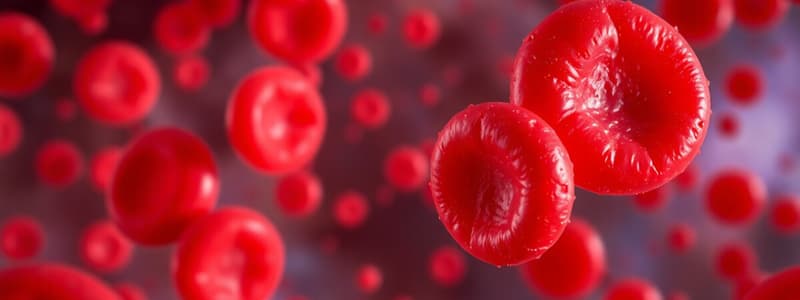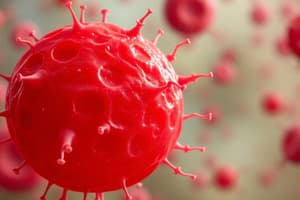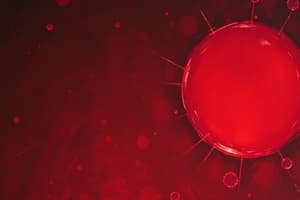Podcast
Questions and Answers
What type of proteins primarily make up the hexagonal lattice in red blood cells?
What type of proteins primarily make up the hexagonal lattice in red blood cells?
- Spectrin tetramers (correct)
- Collagen fibers
- Actin monomers
- Globular proteins
What is the approximate distance of globular ankyrin structures from the distal ends of spectrin filaments?
What is the approximate distance of globular ankyrin structures from the distal ends of spectrin filaments?
- 60 nm
- 80 nm (correct)
- 100 nm
- 50 nm
Which component is found in cross-linking junctional complexes along with protein 4.1?
Which component is found in cross-linking junctional complexes along with protein 4.1?
- Intermediate filaments
- F-actin filaments (correct)
- Myosin filaments
- Microtubules
What condition is associated with hereditary spherocytosis based on membrane protein properties?
What condition is associated with hereditary spherocytosis based on membrane protein properties?
What staining method is used to separate proteins via SDS–PAGE?
What staining method is used to separate proteins via SDS–PAGE?
What is the inheritance pattern for Hereditary Stomatocytosis in most patients with severe hemolysis?
What is the inheritance pattern for Hereditary Stomatocytosis in most patients with severe hemolysis?
What primarily causes the swelling of erythrocytes in Hereditary Stomatocytosis?
What primarily causes the swelling of erythrocytes in Hereditary Stomatocytosis?
Which cells are characteristic of a blood smear from a patient with Hereditary Xerocytosis?
Which cells are characteristic of a blood smear from a patient with Hereditary Xerocytosis?
What is the main cause of cell dehydration in Hereditary Xerocytosis?
What is the main cause of cell dehydration in Hereditary Xerocytosis?
Which abnormality is associated with Hereditary Stomatocytosis?
Which abnormality is associated with Hereditary Stomatocytosis?
What is the classification of hereditary defects affecting the red cell membrane primarily based on?
What is the classification of hereditary defects affecting the red cell membrane primarily based on?
Which type of hereditary defect is characterized by spherocytes?
Which type of hereditary defect is characterized by spherocytes?
The defect in which kind of interaction contributes to spherocyte formation?
The defect in which kind of interaction contributes to spherocyte formation?
Which of the following disorders is included in morphologically related disorders to hereditary elliptocytosis?
Which of the following disorders is included in morphologically related disorders to hereditary elliptocytosis?
Hereditary acanthocytosis results from defects primarily affecting which aspect of red cell morphology?
Hereditary acanthocytosis results from defects primarily affecting which aspect of red cell morphology?
Defects in spectrin dimer self-association primarily lead to which type of red cell alteration?
Defects in spectrin dimer self-association primarily lead to which type of red cell alteration?
Which hereditary defect is characterized by a defect in the horizontal interaction of the red cell membrane?
Which hereditary defect is characterized by a defect in the horizontal interaction of the red cell membrane?
Hereditary xerocytosis is primarily associated with which type of morphological change?
Hereditary xerocytosis is primarily associated with which type of morphological change?
What red cell morphology is commonly associated with hereditary spherocytosis?
What red cell morphology is commonly associated with hereditary spherocytosis?
Which condition is associated with the presence of target cells?
Which condition is associated with the presence of target cells?
What red blood cell morphology is associated with acute hepatic necrosis?
What red blood cell morphology is associated with acute hepatic necrosis?
In which condition do you expect to see bizarre poikilocytes?
In which condition do you expect to see bizarre poikilocytes?
Which morphology is typically seen in megaloblastic anemia?
Which morphology is typically seen in megaloblastic anemia?
What red blood cell morphology is associated with uremia?
What red blood cell morphology is associated with uremia?
Which red cell morphology indicates hereditary elliptocytosis?
Which red cell morphology indicates hereditary elliptocytosis?
What shape do red blood cells take due to the biconcave disc structure?
What shape do red blood cells take due to the biconcave disc structure?
What condition is associated with intracytoplasmic parasites?
What condition is associated with intracytoplasmic parasites?
Which of the following conditions is related to a defect in the erythropoietic process?
Which of the following conditions is related to a defect in the erythropoietic process?
What condition is most consistent with severe hemolytic episodes after exposure to anti-malarial drugs in a patient with congenital non spherocytic hemolytic anemia?
What condition is most consistent with severe hemolytic episodes after exposure to anti-malarial drugs in a patient with congenital non spherocytic hemolytic anemia?
Hereditary pyropoikilocytosis (HP) is characterized by which of the following features?
Hereditary pyropoikilocytosis (HP) is characterized by which of the following features?
A patient with congenital non spherocytic hemolytic anemia presents with red cell inclusions. What does this indicate about hemoglobin status?
A patient with congenital non spherocytic hemolytic anemia presents with red cell inclusions. What does this indicate about hemoglobin status?
Which specific symptom did the African-American patient experience after taking primaquine?
Which specific symptom did the African-American patient experience after taking primaquine?
What is a common result of G-6-PD deficiency when exposed to oxidative drugs?
What is a common result of G-6-PD deficiency when exposed to oxidative drugs?
In patients presenting with hereditary pyropoikilocytosis, what would you expect to see under microscopic examination?
In patients presenting with hereditary pyropoikilocytosis, what would you expect to see under microscopic examination?
Which of the following conditions does NOT typically cause red cell inclusions due to hemoglobin denaturation?
Which of the following conditions does NOT typically cause red cell inclusions due to hemoglobin denaturation?
What is the primary mechanism leading to hemolysis in G-6-PD deficiency?
What is the primary mechanism leading to hemolysis in G-6-PD deficiency?
What type of anemia is characterized by the premature destruction of red cells?
What type of anemia is characterized by the premature destruction of red cells?
Which of the following is NOT a classification of hemolytic anemia?
Which of the following is NOT a classification of hemolytic anemia?
What is one of the clinical findings associated with hemolytic anemia?
What is one of the clinical findings associated with hemolytic anemia?
Which type of hemolytic anemia is related to hereditary defects?
Which type of hemolytic anemia is related to hereditary defects?
Which laboratory test reflects increased red cell destruction in hemolytic anemia?
Which laboratory test reflects increased red cell destruction in hemolytic anemia?
What is a characteristic feature of hereditary spherocytosis?
What is a characteristic feature of hereditary spherocytosis?
Which condition is classified as an extracorpuscular defect in hemolytic anemia?
Which condition is classified as an extracorpuscular defect in hemolytic anemia?
What is one reason the bone marrow can increase output in response to hemolytic anemia?
What is one reason the bone marrow can increase output in response to hemolytic anemia?
Which of the following conditions leads to increased levels of methemalbumin in the blood?
Which of the following conditions leads to increased levels of methemalbumin in the blood?
What happens to serum unconjugated bilirubin levels in hemolytic anemia?
What happens to serum unconjugated bilirubin levels in hemolytic anemia?
Flashcards
Hemolytic Anemia (HA)
Hemolytic Anemia (HA)
A type of anemia characterized by the premature destruction of red blood cells (RBCs) in the body.
Intracorpuscular Hemolytic Anemia
Intracorpuscular Hemolytic Anemia
A group of anemias where the defect causing hemolysis lies within the red blood cell itself.
Extracorpuscular Hemolytic Anemia
Extracorpuscular Hemolytic Anemia
A group of anemias where the defect causing hemolysis lies outside the red blood cell.
Hereditary Defects of Red Cell Membrane
Hereditary Defects of Red Cell Membrane
Signup and view all the flashcards
Enzyme Defects in Red Blood Cells
Enzyme Defects in Red Blood Cells
Signup and view all the flashcards
Immune Hemolytic Anemia
Immune Hemolytic Anemia
Signup and view all the flashcards
Serum Unconjugated Bilirubin
Serum Unconjugated Bilirubin
Signup and view all the flashcards
Hemoglobinemia
Hemoglobinemia
Signup and view all the flashcards
Hemoglobinuria
Hemoglobinuria
Signup and view all the flashcards
Serum Haptoglobin
Serum Haptoglobin
Signup and view all the flashcards
Red Blood Cell Membrane Skeleton
Red Blood Cell Membrane Skeleton
Signup and view all the flashcards
Spectrin
Spectrin
Signup and view all the flashcards
Junctional Complexes
Junctional Complexes
Signup and view all the flashcards
Ankyrin
Ankyrin
Signup and view all the flashcards
Hereditary Membrane Defects
Hereditary Membrane Defects
Signup and view all the flashcards
Spherocytes
Spherocytes
Signup and view all the flashcards
Elliptocytes
Elliptocytes
Signup and view all the flashcards
Bizarre Poikilocytes
Bizarre Poikilocytes
Signup and view all the flashcards
Stomatocytes
Stomatocytes
Signup and view all the flashcards
Irreversibly Sickled Cells
Irreversibly Sickled Cells
Signup and view all the flashcards
Intraerythrocytic Parasites
Intraerythrocytic Parasites
Signup and view all the flashcards
Prominent Basophilic Stippling
Prominent Basophilic Stippling
Signup and view all the flashcards
Spiculated or Crenated Red Cells
Spiculated or Crenated Red Cells
Signup and view all the flashcards
Target Cells
Target Cells
Signup and view all the flashcards
Nonspecific or Normal Morphology
Nonspecific or Normal Morphology
Signup and view all the flashcards
Hereditary Stomatocytosis
Hereditary Stomatocytosis
Signup and view all the flashcards
Hydrocytosis
Hydrocytosis
Signup and view all the flashcards
Hereditary Xerocytosis
Hereditary Xerocytosis
Signup and view all the flashcards
Hereditary Xerocytosis
Hereditary Xerocytosis
Signup and view all the flashcards
Hereditary Spherocytosis (HS)
Hereditary Spherocytosis (HS)
Signup and view all the flashcards
Hereditary Elliptocytosis (HE)
Hereditary Elliptocytosis (HE)
Signup and view all the flashcards
Hereditary Pyropoikilocytosis (HPP)
Hereditary Pyropoikilocytosis (HPP)
Signup and view all the flashcards
Hereditary Acanthocytosis
Hereditary Acanthocytosis
Signup and view all the flashcards
Vertical Interactions in Red Cell Membrane Defects
Vertical Interactions in Red Cell Membrane Defects
Signup and view all the flashcards
Horizontal Interactions in Red Cell Membrane Defects
Horizontal Interactions in Red Cell Membrane Defects
Signup and view all the flashcards
G-6-PD Deficiency
G-6-PD Deficiency
Signup and view all the flashcards
Thalassemia Major
Thalassemia Major
Signup and view all the flashcards
Pyruvate Kinase Deficiency
Pyruvate Kinase Deficiency
Signup and view all the flashcards
How are Hereditary Stomatocytosis and Hereditary Xerocytosis similar?
How are Hereditary Stomatocytosis and Hereditary Xerocytosis similar?
Signup and view all the flashcards
What happens when a person has Hereditary Stomatocytosis?
What happens when a person has Hereditary Stomatocytosis?
Signup and view all the flashcards
Study Notes
Hemolytic Anemia
- Hemolytic anemia (HA) is a heterogeneous group of normocytic normochromic anemias characterized by premature destruction of red blood cells (RBCs) or a shortened RBC life span.
- Bone Marrow (BM) can increase its output 6-8 fold to compensate for the anemia; which corresponds to an RBC life span of 15-20 days.
Hemolytic Anemia Classification
- Intracorpuscular Defects:
- Hereditary defects:
- Defects in RBC membrane.
- Enzyme defects.
- Hemoglobinopathies.
- Thalassemia syndrome
- Acquired defects: Paroxysmal nocturnal hemoglobinuria (PNH)
- Hereditary defects:
- Extracorpuscular Defects:
- Immune hemolytic anemia.
- Infections.
- Exposure to chemicals and toxins.
- Exposure to physical agents.
- Microangiopathic and macroangiopathic hemolytic anemias.
- Splenic sequestration (hypersplenism)
- General systemic disorders (in which hemolysis is not the dominant feature of the anemia.)
Diagnosis of Hemolytic Anemia (HA)
- Establish the presence of hemolysis:
- Tests reflecting increased RBC destruction:
- Serum un-conjugated (indirect) bilirubin
- Hemoglobinemia
- Hemoglobinuria (dark urine)
- Hemosiderinuria (iron storage protein in a spun deposit of urine)
- Methemalbumin in blood (Schumm’s test)
- Methemoglobinemia
- Serum Hemopexin
- Serum Haptoglobin
- Urine urobilinogen & fecal stercobilinogen
- Tests reflecting increased RBC destruction:
- Tests reflecting increased RBC production
- Reticulocyte count
- Reticulocyte production index (RPI)
- Bone Marrow (BM) erythroid hyperplasia, M:E ratio from 3-4:1 is reduced to 1:1 or even reversed.
- RPI >2.5-3.0 is indicative of HA
Degradation of Hb After Intra- & Extravascular Hemolysis
- When present in large quantities, met-albumin and hemopexin-heme complex imparts a brownish color to plasma.
- Results in hemoglobinuria, hemosiderinuria and urobilinogenuria.
Other important aspects
-
Red cell membrane structure is determined by biconcave disc shape which is a result of Excess SA:Volume ratio; cell volume is 90 µm³ while SA is ~140 µm³.
-
Red cell membrane skeleton network is composed of proteins like spectrin, actin, ankyrin, band 4.1, adducin, etc.
-
Hereditary defects of RBC membrane:
- Hereditary spherocytosis (HS)
- Hereditary elliptocytosis (HE)
- Hereditary pyropoikilocytosis (HPP)
- Hereditary stomatocytosis
- Hereditary xerocytosis
- Hereditary acanthocytosis
-
Hereditary Enzyme deficiencies:
- Glucose-6-Phosphate Dehydrogenase Deficiency (G6PD)
- Pyruvate Kinase (PK) Deficiency
- Methemoglobin Reductase Deficiency
Assessment Questions
- Assessment questions are provided.
Studying That Suits You
Use AI to generate personalized quizzes and flashcards to suit your learning preferences.




